Sutton Hoo: Difference between revisions
mNo edit summary |
|||
| (One intermediate revision by the same user not shown) | |||
| Line 1: | Line 1: | ||
[[File:Sutton hoo helmet room 1 no flashbrightness ajusted.JPG|right|thumb|300px|The ceremonial helmet from Sutton Hoo]] | [[File:Sutton hoo helmet room 1 no flashbrightness ajusted.JPG|right|thumb|300px|The ceremonial helmet from Sutton Hoo]] | ||
[[File:Sutton Hoo burial ground | [[File:Sutton Hoo burial ground 4.jpg|thumb|250px|Part of the burial ground at Sutton Hoo]] | ||
{{county|Suffolk}} | {{county|Suffolk}} | ||
'''Sutton Hoo''' is a farm estate, near [[Woodbridge, Suffolk|Woodbridge]], in [[Suffolk]], and it is world-famous as the site of two 6th- and early 7th-century cemeteries, in one of which was found the Sutton Hoo treasure. In a burial mound at Sutton Hoo excavated in 1939 was found an undisturbed ship burial including a wealth of grave goods; Anglo-Saxon artefacts of outstanding art-historical and archaeological significance, which are now held in the [[British Museum]] in London. | '''Sutton Hoo''' is a farm estate, near [[Woodbridge, Suffolk|Woodbridge]], in [[Suffolk]], and it is world-famous as the site of two 6th- and early 7th-century cemeteries, in one of which was found the Sutton Hoo treasure. In a burial mound at Sutton Hoo excavated in 1939 was found an undisturbed ship burial including a wealth of grave goods; Anglo-Saxon artefacts of outstanding art-historical and archaeological significance, which are now held in the [[British Museum]] in London. | ||
| Line 62: | Line 62: | ||
*A sword with a gold and garnet cloisonné pommel {{convert|85|cm|in|0|x}} long, its pattern-welded blade still within its scabbard | *A sword with a gold and garnet cloisonné pommel {{convert|85|cm|in|0|x}} long, its pattern-welded blade still within its scabbard | ||
**Sword harness and belt, fitted with gold mounts and strap-distributors of intricate garnet cellwork ornament.<ref>Evans 1986, 44–46.</ref> | **Sword harness and belt, fitted with gold mounts and strap-distributors of intricate garnet cellwork ornament.<ref>Evans 1986, 44–46.</ref> | ||
[[File: | [[File:Belt buckle.jpg|right|thumb|200px|Great Buckle]] | ||
[[File:Sutton.Hoo.ShoulderClasp2.RobRoy.jpg|right|thumb|200px|Shoulder-clasps]] | [[File:Sutton.Hoo.ShoulderClasp2.RobRoy.jpg|right|thumb|200px|Shoulder-clasps]] | ||
[[File:Sutton.Hoo.PurseLid.RobRoy.jpg|right|thumb|200px|Purse cover]] | [[File:Sutton.Hoo.PurseLid.RobRoy.jpg|right|thumb|200px|Purse cover]] | ||
Latest revision as of 21:14, 27 July 2015


Sutton Hoo is a farm estate, near Woodbridge, in Suffolk, and it is world-famous as the site of two 6th- and early 7th-century cemeteries, in one of which was found the Sutton Hoo treasure. In a burial mound at Sutton Hoo excavated in 1939 was found an undisturbed ship burial including a wealth of grave goods; Anglo-Saxon artefacts of outstanding art-historical and archaeological significance, which are now held in the British Museum in London.
Sutton Hoo is of a primary importance to early mediæval historians because it sheds light on a period of English history that is on the margin between myth, legend, and historical documentation. Use of the site culminated at a time when Rædwald, King of the East Angles, held senior power among the English people and played a dynamic if ambiguous part in the establishment of Christian rulership in England; it is generally thought most likely that he is the person buried in the ship. The site has been vital in understanding the Anglo-Saxon Kingdom of East Anglia and the whole early Anglo-Saxon period.
Location

Sutton Hoo is the name of an area spread along the bank of the River Deben opposite the harbour of the small Suffolk town of Woodbridge. About 7 miles from the sea, it overlooks the tidal estuary a little below the lowest convenient fording place. The welcoming mouth of the Deben is believed to have formed a path of entry into East Anglia during the migration period that followed the end of Roman imperial rule in the 5th century.[1]
South of Woodbridge, there are 6th-century burial grounds at Rushmere, Little Bealings and Tuddenham St Martin[2] and circling Brightwell Heath, the site of mounds that date from the Bronze Age.[3] There are cemeteries of a similar date at Rendlesham and Ufford.[4] A ship-burial at Snape is the only one in Britain that can be compared to the example at Sutton Hoo.[5]
The territory between the Orwell and the watersheds of the Alde and Deben rivers may have been an early centre of royal power, originally centred upon Rendlesham or Sutton Hoo, and a primary component in the formation of the East Anglian kingdom. In the early 7th century, Gipeswic (modern Ipswich) began its growth as a centre for foreign trade,[6] Botolph's monastery at Iken was founded by royal grant in 654,[7] and Bede identified Rendlesham as the site of King Æthelwold's royal dwelling.[8][9]
Burials

The ship-burial, probably dating from the early 7th century and excavated in 1939, is one of the most magnificent archaeological finds in Britain for its size and completeness, far-reaching connections, the quality and beauty of its contents, and the profound interest of the burial ritual itself.
The initial excavation was privately sponsored by the landowner, but when the significance of the find became apparent, national experts took over. Subsequent archaeological campaigns, particularly in the late 1960s and late 1980s, have explored the wider site and many other individual burials. The most significant artefacts from the ship-burial, displayed in the British Museum, are those found in the burial chamber, including a suite of metalwork dress fittings in gold and gems, and pieces from a ceremonial helmet, shield and sword, a harp (lyre), and many pieces of silver plate from the Eastern Roman Empire. The ship-burial has from the time of its discovery prompted comparisons with the world described in the heroic Old English poem Beowulf, which is set in Denmark and Geatland (southern Sweden), and it is in Scandinavia that close archaeological parallels to the ship-burial are found, both in its general form and in details of the military equipment that the burial contains. The ship burial described in Beowulf is echoed on the Deben, albeit that in the poem Scyld's ship is set to sail unmanned into the sea.
There is rich historical context to the two separate cemeteries, not just the major ship burial, in their position in relation to the Deben estuary and the North Sea, and their relation to other sites in the immediate neighbourhood. Of the two grave fields found at Sutton Hoo, one (the "Sutton Hoo cemetery") had long been known to exist because it consists of a group of approximately 20 earthen burial mounds that rise slightly above the horizon of the hill-spur when viewed from the opposite bank. The other, called here the "new" burial ground, is situated on a second hill-spur close to the present Exhibition Hall, about 500 yards upstream of the first, and was discovered and partially explored in 2000 during preparations for the construction of the hall. This also had burials under mounds, but was not known because they had long since been flattened by agricultural activity. The site has a visitor's centre, with many original and replica artefacts and a reconstruction of the ship burial chamber, and the burial field can be toured in the summer months.
Mounds and artefacts
Other burials of this period have been found, most notably at Spong Hill and Snape, where a large number of cremations and inhumations were found. Many of the graves were accompanied by grave goods, which included combs, tweezers and brooches, as well as weapons. Sacrificed animals had been placed in the graves.[10]
At the time when the Sutton Hoo cemetery was in use, the River Deben would have formed part of a busy trading and transportation network. A number of settlements grew up along the river, most of which would have been small farmsteads, although it seems likely that there was a larger administrative centre as well, where the local aristocracy held court. Archaeologists have speculated that such a centre may have existed at Rendlesham, Melton, Bromeswell or at Sutton Hoo. It has been suggested that when wealthier families buried their dead in burial mounds, these were later used as sites for early churches. In such cases, the mounds would have been destroyed.[11]
The Sutton Hoo grave field contained about twenty barrows and was reserved for people who were buried individually with objects that indicated that they had exceptional wealth or prestige. It was used in this way from around 575 to 625 and contrasts with the Snape cemetery, where the ship-burial and furnished graves were added to a graveyard of buried pots containing cremated ashes.

The Sutton Hoo Hoard - Mound 1
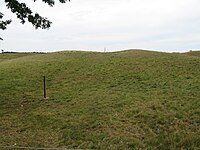
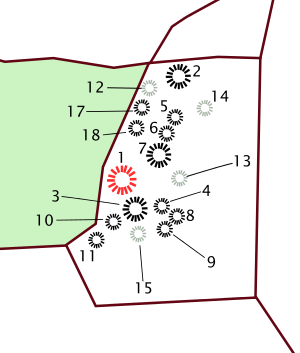
The ship-burial discovered under Mound 1 in 1939 contained one of the most magnificent archaeological finds in Britain for its size and completeness, far-reaching connections, the quality and beauty of its contents, and for the profound interest it generated.

Although practically none of the original timber survived, the form of the ship was perfectly preserved.[12] Stains in the sand had replaced the wood but had preserved many construction details. Nearly all of the iron planking rivets were in their original places. It was possible to survey the original ship, which was found to be 89 feet long, pointed at either end with tall rising stem and stern posts and widening to 14 feet in the beam amidships with an inboard depth of 5 feet over the keel line. From the keel board, the hull was constructed clinker-built with nine strakes, fastened with rivets. Twenty-six wooden frames strengthened the form. Repairs were visible: this had been a seagoing vessel of excellent craftsmanship. The decking, benches, mast and mast-step were removed. In the fore and aft sections, there were Þ-shaped oar-rests along the gunwales, indicating that there may have been positions for forty oarsmen. The central chamber had timber walls at either end and a roof, which was probably pitched.
The heavy oak vessel had been hauled from the river up the hill and lowered into a prepared trench, so only the tops of the stem and stern posts rose above the land surface.[13] After the addition of the body and the artefacts, an oval mound was constructed, which covered the ship and rose above the horizon at the riverward side of the cemetery.[14] The view to the river is now obscured by Top Hat Wood, but the mound would have been a visible symbol of power to those using the waterway. This appears to have been the final occasion upon which the Sutton Hoo cemetery was used for its original purpose.[15]
Long afterwards, the roof collapsed violently under the weight of the mound, compressing the ship's contents into a seam of earth.[16]
The body in the ship
No body was not found, and there was early speculation that the ship-burial was a cenotaph, but soil analyses conducted in 1967 found phosphate traces, supporting the view that a body had disappeared in the acidic soil.[17] The presence of a platform (or a large coffin) that was about 9 feet long was indicated.[18] An iron-bound wooden bucket, an iron lamp containing beeswax and a bottle of north continental manufacture were close by. The objects around the body indicate that it lay with the head at the west end of the wooden structure.
Artefacts near the body have been identified as regalia, pointing to it being that of a king.[19] Most of the suggestions for the occupant are East Anglian kings because of the proximity of the royal vill of Rendlesham.[19] Since 1940, when H.M. Chadwick first ventured that the ship-burial was probably the grave of Rædwald,[20] scholarly opinion divided between Raedwald and his son (or step-son) Sigeberht.[17] The man who was buried under Mound 1 cannot be identified,[21] but the identification with Rædwald still has widespread scholarly acceptance, though from time to time, other identifications are suggested, including his son Eorpwald, who succeeded his father in about 624. Rædwald is the most likely of the candidates because of the high quality of the imported and commissioned materials and the resources needed to assemble them, the authority that the gold was intended to convey, the community involvement required to conduct the ritual at a cemetery reserved for an elite, the close proximity of Sutton Hoo to Rendlesham and the probable date horizons.
The objects in the burial chamber
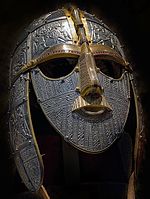
David M Wilson has remarked that the metal artworks found in the Sutton Hoo graves were "work of the highest quality, not only in English but in European terms".[22] Sutton Hoo is a cornerstone of the study of art in Britain in the 6th–9th centuries. George Henderson has described the ship treasures as "the first proven hothouse for the incubation of the Insular style".[23] The gold and garnet fittings show the creative fusion of earlier techniques and motifs by a master goldsmith. Insular art drew upon Irish, Pictish, Anglo-Saxon, native British and Mediterranean artistic sources: the 7th-century Book of Durrow owes as much to Pictish sculpture, British millefiori and enamelwork and Anglo-Saxon cloisonné metalwork as it does to Irish art. The Sutton Hoo treasures represent a continuum from pre-Christian royal accumulation of precious objects from diverse cultural sources, through to the art of gospel books, shrines and liturgical or dynastic objects.
Items found include:
- A crested and masked helmet wrapped in cloths, highly decorated but rusted into many pieces, and with it:
- On the right of the body position, weapons and regalia:
- A sword with a gold and garnet cloisonné pommel 33 inches long, its pattern-welded blade still within its scabbard
- Sword harness and belt, fitted with gold mounts and strap-distributors of intricate garnet cellwork ornament.[28]

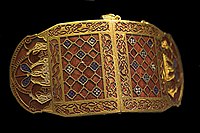
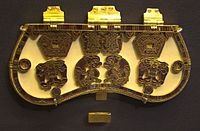
- The great gold buckle, made in three parts, 5 inches long.
- Shoulder-clasps
- Purse cover (the purse contained thirty-seven gold shillings or tremisses from Frankland.
- By the legs, drinking vessels and metalwork:
- A pair of drinking horns made from the horns of an aurochs, extinct since the early Middle Ages.
- A set of maplewood cups with similar rim-mounts and vandykes,[29] and a heap of folded textiles lay on the left side.
- Miscellaneous metal objects and textiles in two folded or packed heaps on the east end of the central wooden structure.
- A long coat of ring-mail, made of alternate rows of welded and riveted iron links,[30]
- Two hanging bowls,[31] leather shoes,[32]
- An iron hammer-axe
- A fluted silver dish with drop handles, probably of Italian make, containing cups with rim-mounts, combs of antler, small metal knives, a small silver bowl, and various other small effects (possibly toilet equipment), and including a bone gaming-piece.
- A very large round silver platter with chased ornament, made in the Eastern Empire circa 500 and bearing the control stamps of Emperor Anastasius I.
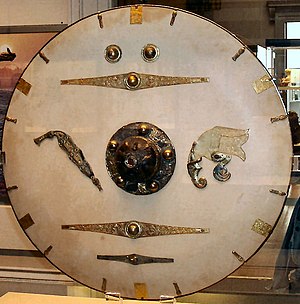
- Along the inner west wall, some larger ojects:
- A tall iron stand with a grid near the top.
- A very large circular shield,[33] with a central boss, mounted with garnets and with die-pressed plaques of interlaced animal ornament.
- A long, square-sectioned whetstone, tapered at either end and carved with human faces on each side. A ring mount, topped by a bronze antlered stag figurine, was fixed to the upper end. The purpose of this 'sceptre' has generated considerable debate and a number of theories, some wilder than others.
- In the southwest corner a miscellany:
- A Coptic or eastern Mediterranean bronze bowl with drop handles and figures of animals;
- A badly deformed six-stringed Anglo-Saxon hearp (a lyre) in a beaver-skin bag;
- A large and exceptionally elaborate three-hooked hanging bowl;
- Millefiori mounts showing fine-line spiral ornament and red cross motifs and with an enamelled metal fish mounted to swivel on a pin within the bowl.[34]
- At the east end of the chamber:
- An iron-bound tub of yew containing a smaller bucket.
- Two small bronze cauldrons;
- A large, carinated bronze cauldron, similar to the example from a chamber-grave at Taplow';
- An iron chain almost 11 feet long, probably for hanging the cauldron.
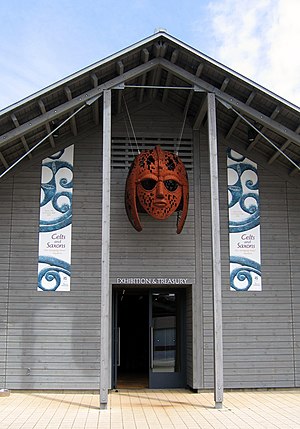
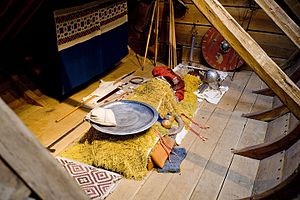
Exhibition
The ship-burial treasure was presented to the nation by the owner, Mrs Pretty, and was at the time the largest gift made to the British Museum by a living donor.[35] The principal items are now permanently on display at the British Museum. A display of the original finds excavated in 1938 from Mounds 2, 3 and 4, and replicas of the most important items from Mound 1, can be seen at the Ipswich Museum.
In the 1990s, the Sutton Hoo site, including Sutton Hoo House, was given to the National Trust by the Trustees of the Annie Tranmer Trust. At Sutton Hoo's visitor centre and Exhibition Hall, the newly found hanging bowl and the Bromeswell Bucket, finds from the equestrian grave and a recreation of the burial chamber and its contents can be seen.
The 2001 Visitor Centre was designed by van Heyningen and Haward Architects for the National Trust and involved the overall planning of the estate, the design of an exhibition hall and visitor facilities, car parking and the restoration of a fine Edwardian house to provide additional facilities.[36]
Outside links
| ("Wikimedia Commons" has material about Sutton Hoo) |
- Sutton Hoo - National Trust
- 'Sutton Hoo:Burial Ground of the Wuffings', by Sam Newton.
- The Sutton Hoo Society website
References
- ↑ West 1998, 261–275.
- ↑ West 1998, 9–10, 92–3, 99.
- ↑ West 1998, 12–3.
- ↑ West 1998, 91, 100–101.
- ↑ Bruce-Mitford 1974, 114–140.
- ↑ Wade 2001.
- ↑ West, Scarfe and Cramp 1984.
- ↑ Historia Ecclesiastica, iii.22.
- ↑ Bruce-Mitford 1974, 73–113; however Kingston near Woodbridge (nearly opposite Sutton Hoo) is "another possibility" (see Scarfe 1986, 4, 30).
- ↑ Carver, Sutton Hoo, pp. 103-104.
- ↑ Carver, Sutton Hoo, p. 107.
- ↑ A.C. Evans and R. Bruce-Mitford in Bruce-Mitford 1975, 345–435; Evans 1986, 23–29. For its context in symbolism, see Crumlin-Pederson 1995.
- ↑ BruceMitford 1975, 176–180; Evans 1986, 32–40
- ↑ Bruce-Mitford 1975, 144–156.
- ↑ Carver, Sutton Hoo, pp. 132–135. Several mounds remain unexcavated, see p. 179.
- ↑ Bruce-Mitford 1975, 488–577.
- ↑ 17.0 17.1 "British Museum - Who was buried at Sutton Hoo?". www.britishmuseum.org. http://www.britishmuseum.org/explore/highlights/article_index/w/who_was_buried_at_sutton_hoo.aspx. Retrieved 2010-10-19.
- ↑ Carver 1998, 188, Ch. 3 n.13.
- ↑ 19.0 19.1 Tanya Knight Ruffin (August 2006). Sutton Hoo: The Body in the Mound - A Thesis. Louisiana State University. p. 43. http://etd.lsu.edu/docs/available/etd-04052006-161157/unrestricted/Ruffin_thesis.pdf. Retrieved 2010-10-19.
- ↑ In Phillips et al. 1940, 76–87.
- ↑ Bruce-Mitford 1975, 683–717.
- ↑ Wilson, Anglo-Saxon Art, p. 25.
- ↑ Henderson and Henderson 2004, 15–29, quote at p. 16.
- ↑ Bruce-Mitford 1983 (I), 69–146.
- ↑ Evans 1986, 59–63; Plunkett 2001, 66–71.
- ↑ Bruce-Mitford 1978, 241–272.
- ↑ Bruce-Mitford 1978, 394–402; Evans 1986, 92–93.
- ↑ Evans 1986, 44–46.
- ↑ Bruce-Mitford 1983 (I), 347–360; Evans 1986, 64–68.
- ↑ Bruce-Mitford 1978, 232–240; Evans 1986, 41.
- ↑ Bruce-Mitford 1983 (I), 244–262, 282–295.
- ↑ See K. East in Bruce-Mitford 1983 (II), 788–812.
- ↑ Bruce-Mitford 1978, 1–129.
- ↑ T.D. Kendrick in Phillips et al. 1940, 30–34; Bruce-Mitford 1983 (I), 206–243, 264–281, 300–306; Evans 1986, 72–75.
- ↑ Carver, Sutton Hoo, p. 22.
- ↑ http://www.architectsjournal.co.uk/home/modest-building-fit-for-a-king/177342.article
